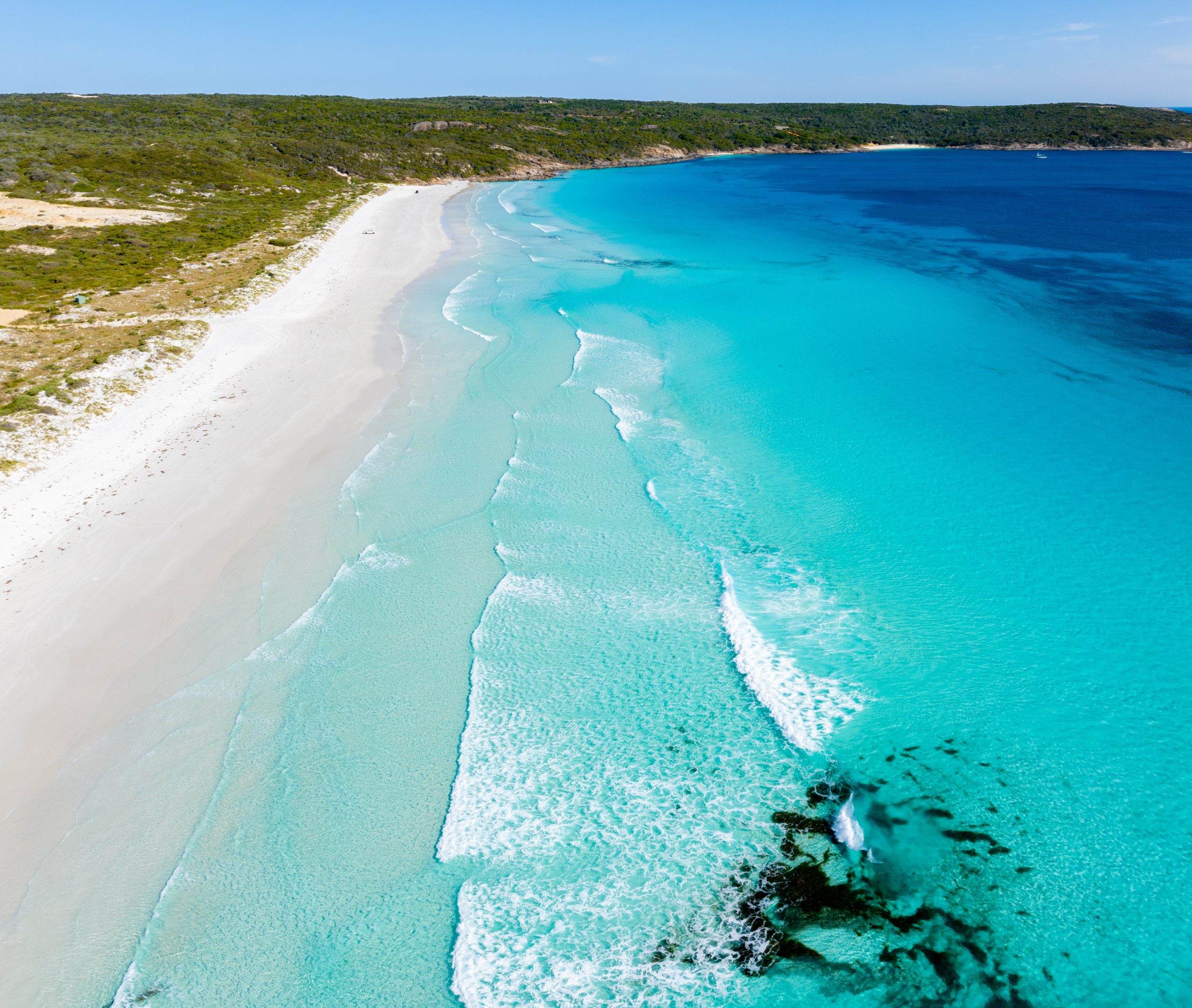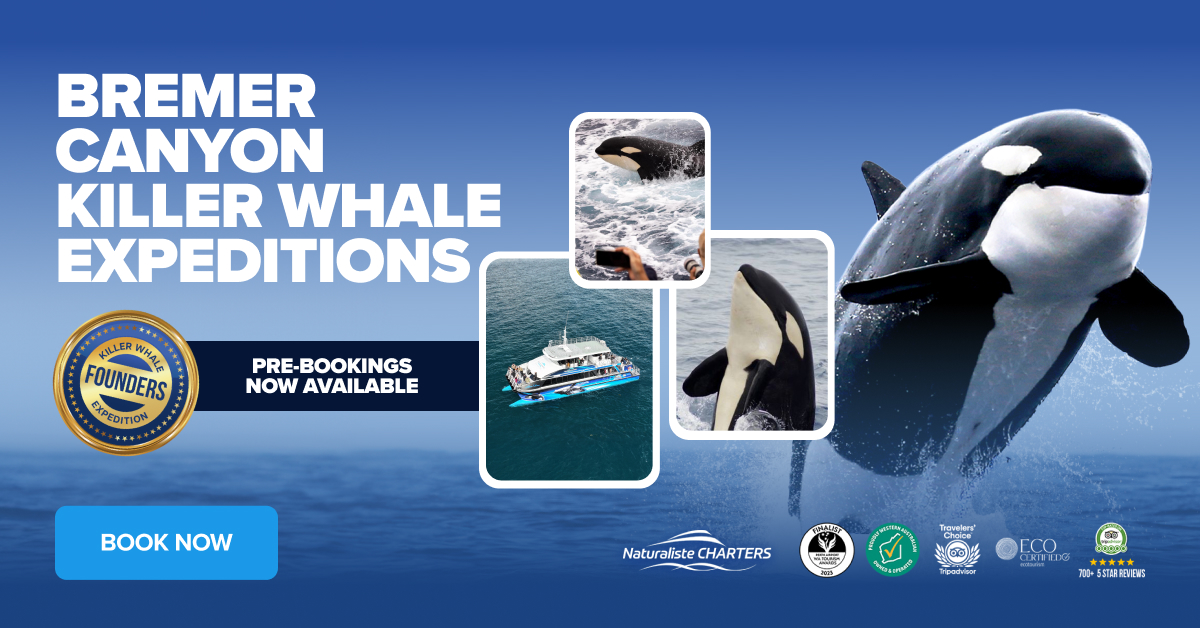Highlights from a Wild Week in the Bremer Canyon
This week delivered some of the most memorable wildlife highlights of the season. From dramatic weather shifts to tender calf moments, the Bremer Canyon kept us guessing each day. No two trips were alike—and that’s the magic of this place.
Across the week, we witnessed feeding frenzies, close passes from familiar orcas like Digby and Nibbles, and the stunning arrival of a brand-new calf. From sperm whales to albatrosses, and even a hammerhead shark, the Southern Ocean revealed its rich and unpredictable character. These highlights offer just a glimpse into the natural wonders unfolding offshore—and every day left us wanting more.
March 11 – Humble Wild Highlights
Today reminded us we have no control over when or how the orca will appear in Bremer Canyon. We set off across the continental shelf in clear conditions, hopeful and excited to meet our regular visitors at the hotspot. But the ocean was quiet, offering only a few vacant bird swirls and no signs of life.
With little action at the hotspot, we turned east then pushed west into a deep area called ‘Shreks’, named after its shape. We searched with patience, scanning every ripple and swirl for any hint of movement. As time passed, we circled back toward the hotspot, still unsure what the day might hold.
Near the southern end of the hotspot, a slick shimmered on the surface, surrounded by shearwaters riding the breeze. Just after 2:30pm, the call came—blows ahead! Everyone jumped up, recharged with excitement and ready to move. Then suddenly, behind us in the wake, a passenger spotted something rising from the depths.
It was Digby, a large male, alone but playful. He surfaced beside the boat, rolled beneath us three times, then drifted away. Moments later, three more orca appeared. We recognised Slug and Dundette as they cruised beside the bow before vanishing into the glare.
They grew hard to follow as the light danced across the water. Each time we approached, they slipped beneath again. Today’s brief highlights reminded us this is their world, and every moment with them is on their terms. It’s never guaranteed, but always a privilege.
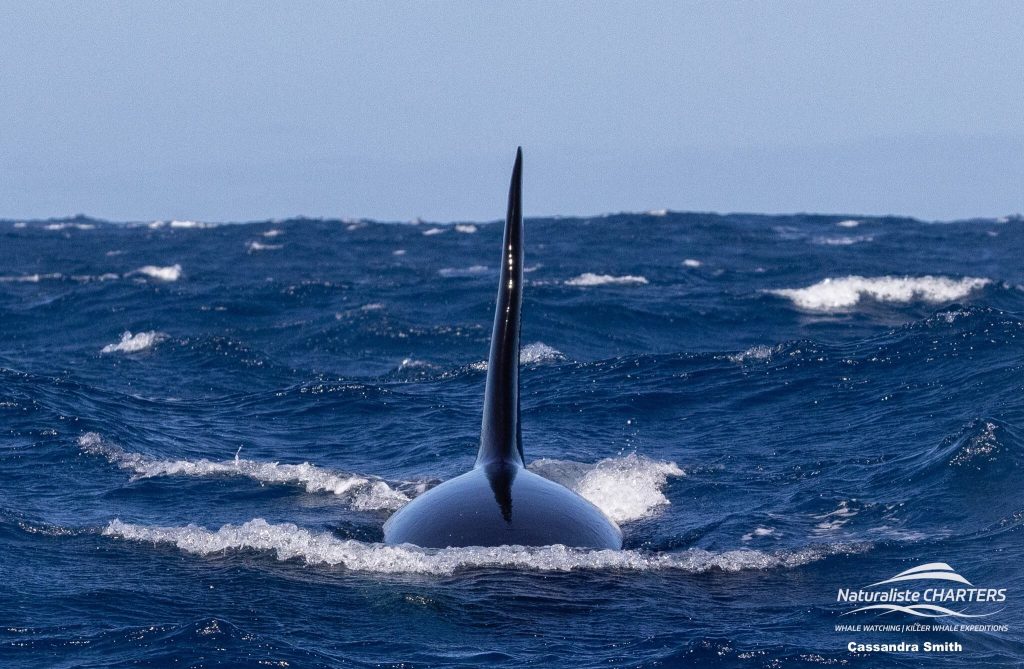
March 13 – Orca & Sperm Whale Highlights
The day began with an exciting surprise—over 50 bottlenose dolphins greeted us as we left the harbour. They swam directly toward the boat, bow-riding with ease. Among them, tiny calves showed their foetal folds, a sign of recent birth. After a few joyful minutes, they peeled away, letting us continue.
At the hotspot, the sea was calm and the sun was shining, but orcas were nowhere in sight. With only a few scattered shearwaters overhead, we turned southeast. Not long after, a splash broke the surface—two orcas appeared, charging forward.
It was Akama and her young calf Wren, bursting into view beside our boat. They surfaced together near the bow before slipping below again. A nearby sunfish caught our attention next, flapping its fin gently above the surface.
Soon, two more orcas arrived, unrelated to Akama’s group. They led us even farther south, diving deep and covering huge distances between breaths. We found ourselves 34 nautical miles offshore—closer to Antarctica than home.
As we returned north, a tall dorsal fin broke the surface—Akama’s pod was reunited. Wren, Akama, Nibbles, and matriarch Fanscar all swam together, putting on a show. Nibbles cruised beside us, rising slowly to show off his bulk while Wren popped up beside him.
Their close contact was heartwarming—rubbing, rolling, and swimming side by side. Fanscar glided near the boat, with Nibbles flashing his white belly as he rolled underneath her. The family seemed relaxed and sociable, offering one of the most touching highlights of the week.
Just when we thought the day was done, Crossy spotted large, distant blows. As we approached, we realised we were among over 40 sperm whales. Their bushy exhalations rose all around us, framed by storm petrels dancing above the still sea.
As we cruised through the pod, the whales were calm and unbothered. Two lifted their flukes high and disappeared into the deep, a perfect ending to a remarkable day.

March 14 – Feeding Frenzy Highlights
Drizzle and grey clouds set a moody tone as we boarded Alison Maree, heading south toward the continental shelf. Spirits remained high despite the soggy start, and it wasn’t long before we spotted blows at the hotspot.
Excitement erupted as orcas surfaced on both sides of the vessel. Razor, with her distinct notched dorsal fin, was easily recognised. She was joined by Blade, Slug, Dundette, Mia, and the charismatic male, Digby.
Another orca group surged toward our bow, diving under the boat and emerging off the stern. Bridled terns followed above, while juvenile tuna exploded from the water, fleeing the chaos below.
Small oil slicks on the surface hinted at active feeding. The groups stayed with us for hours, offering countless close passes. Young Wren and playful Nibbles especially enjoyed lingering nearby.
With the action slowing, we drifted west under a dramatic lightning show, just as another squall approached. Bird activity picked up quickly, and we spotted Indian yellow-nosed, black-browed, and two wandering albatrosses soaring above.
Ahead, more orca blows—this time from Kwilana’s group. Among them was Blackberry, a huge mature male, powering toward the hotspot. Before long, they melted into the mist and rain returned.
On the way home, the skies cleared again. We took a scenic detour along the cliffs, escorted by bottlenose dolphins. Glasse Island gave us a final treat—Australian sea lions basking in the sun.
This day was packed with energetic orca activity, rare seabirds, and memorable feeding highlights in every direction.
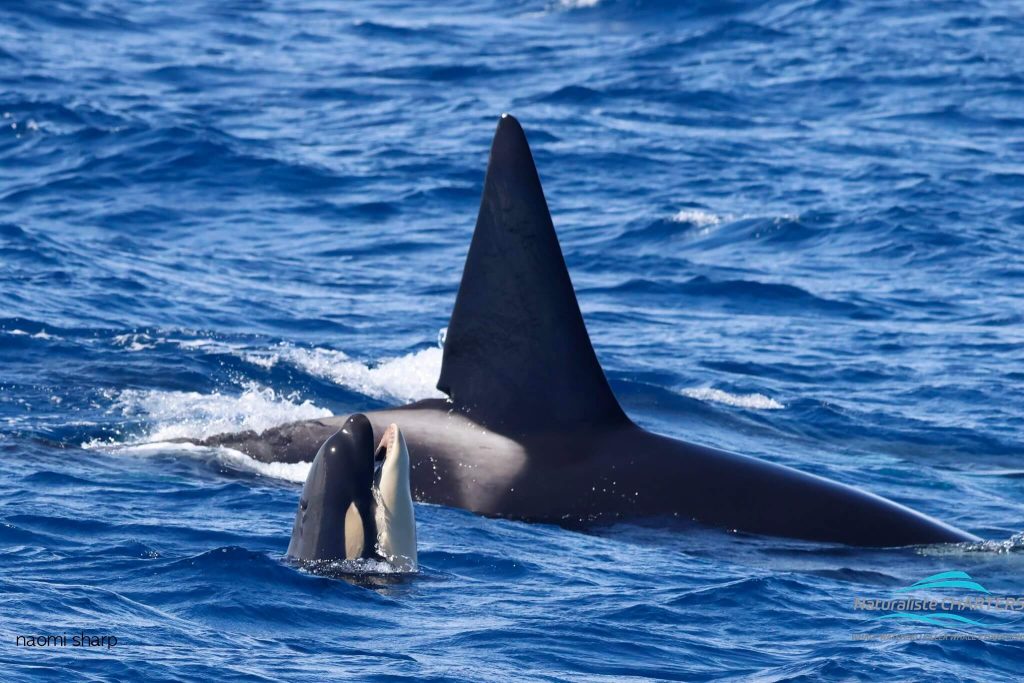
March 15 – Playful Calf & Feeding Highlights
A light drizzle welcomed us aboard Alison Maree as we cruised out into the Southern Ocean. A brief rainbow touched the sea before vanishing into grey skies.
At the hotspot, the mood was dramatic—squalls rolled through as we scanned the choppy surface. A sunfish appeared first, then faded behind us as orca blows drew all eyes forward.
Digby’s tall, wobbly fin broke the surface, triple the height of nearby females. He surfaced beside Razor and her calf Blade. The group cruised past us close on the port side, their size truly awe-inspiring.
Akama and her calf Wren were tagging along with Razor’s family. These groups are often seen together—possibly separate pods, maybe just tightly bonded.
Wren, just five weeks old, was as playful as ever. She leapt, tail-flipped, spy-hopped, and rolled unpredictably, keeping everyone captivated.
All around, oily slicks formed—signs of another feeding session. Pilchards and tuna launched into the air, fleeing the frenzy below.
Shearwaters dove into the slicks, claiming their share with ease. These agile birds can dive over 30 metres in pursuit of prey.
Albatrosses soared above, their vast wingspans slicing the wind as they glided between swells, scanning for food stirred up by the orca.
At one point, a flash of turquoise darted beneath the bow—a belly-up orca, showing off its white underside. Dundette spy-hopped nearby, catching eyes and smiles from those onboard.
Akama and Wren returned, zipping toward Razor’s group. Wren breached twice, earning gasps and applause with her acrobatic flair.
It was a day full of life, movement, and joyful highlights—proof again of nature’s unpredictable brilliance.
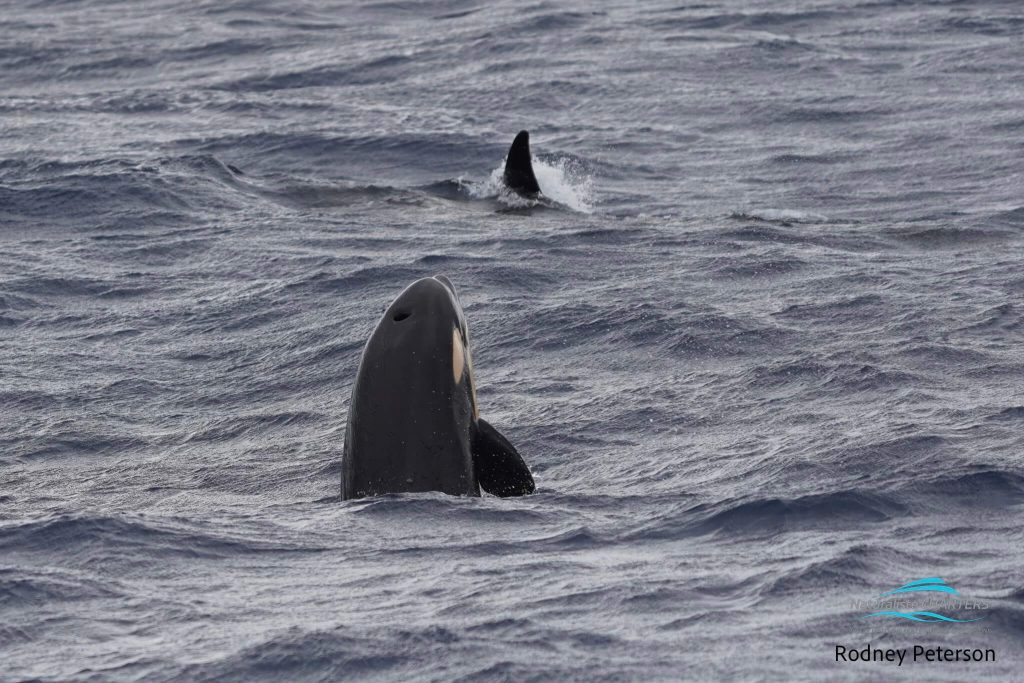
March 16 – New Calf and Predator Highlights
A crisp morning hinted at action ahead. The scent of mammal and a shimmering oily slick signalled orca were nearby. Storm petrels circled overhead, diving to snatch leftovers from the surface.
The first dorsal fin we saw was tall and clean—Nani, the only mature male in Alki’s family. A tail slap echoed across the water as eight orcas burst into view. Nani passed the bow holding a chunk of meat, feeding in full display.
Alki’s group moved fast, the ocean alive with energy. But the real highlight was still to come.
From the distance came a Canyon legend—Split Tip, the wise grandmother. She arrived with several family members, their presence commanding. Then, a surprise: a tiny orange-tinged calf surfaced briefly beside her. It was no more than two weeks old.
The moment was fleeting. Split Tip and her calf vanished into the deep, leaving everyone speechless. It was a rare and beautiful encounter—one of the week’s top highlights.
Later, Razor’s family appeared, led as always by little Wren. She travelled with Akama and playful Nibbles, vanishing together on a long dive. As we scanned the water, a lone fin approached.
At first, we expected another orca, but this sleek dorsal belonged to a hammerhead shark. It circled close, offering a rare look before slipping away.
Just when we thought the day was done, two enormous bulls arrived—Chalky and Hookfin. Their towering fins sliced through the waves as they passed in silent power.
Nearly 40 orca sightings, two new calves, and a curious shark made this day unforgettable—a true showcase of nature’s raw highlights.
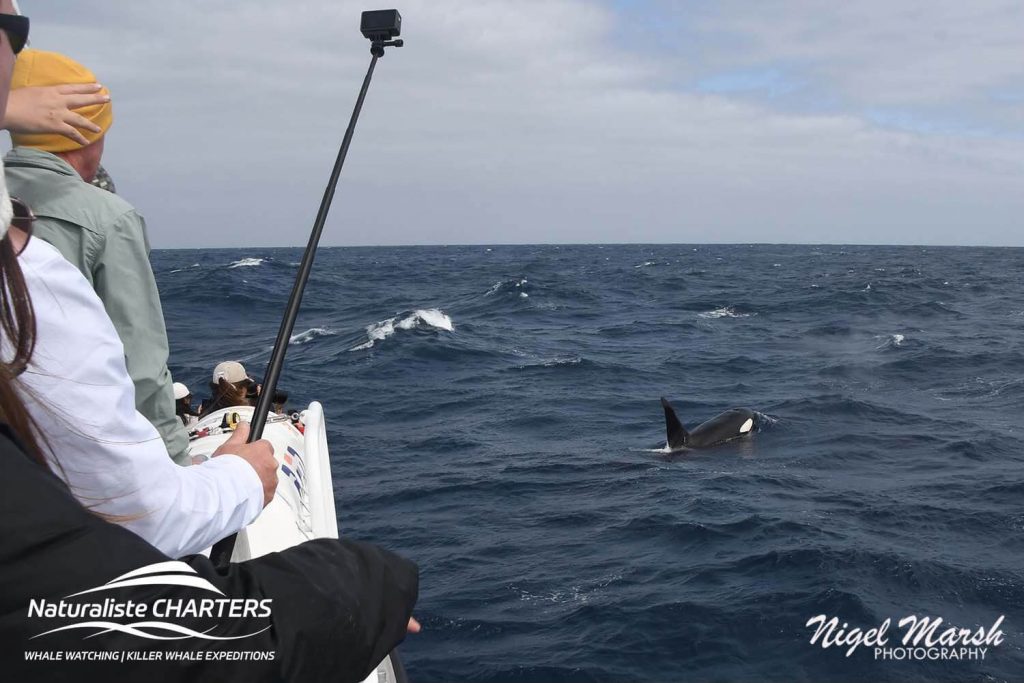
March 17 – Calf Close Passes
Sunlight peeked through the clouds as we boarded Alison Maree, filled with anticipation. Each day brings something completely new—and today was no exception.
Not long after arriving at the hotspot, tall dorsal fins pierced the surface. Split Tip was leading the way, instantly recognisable by her Y-shaped notch. To everyone’s delight, the new calf seen only yesterday surfaced again, sticking closely beside Tarni, who we believe is its mother.
This tiny orca is likely just days old. Female orcas nurse their calves through mammary slits, activated by the calf’s nuzzling. Weaning takes nearly two years. Tarni’s previous calf, Ripple, was born three years ago—so the timing fits perfectly.
As they foraged, juvenile tuna skipped across the surface and oil slicks spread slowly behind the pod. Flesh-footed shearwaters circled above, joined by storm petrels, wandering and black-browed albatrosses, and even a skua.
The orcas surfaced briefly between long dives, working the area methodically. We watched smaller groups split off across the hotspot, creating a beautiful, fluid mosaic of motion.
Wonks surfaced behind us, his large fin wobbling through the swell. Adeano popped up at our eleven o’clock, joined by young juveniles showing curiosity and energy.
The swell made each surfacing more dramatic. Their heads rose completely above the waves, white eyepatches shining through the spray. Some rode the wake, others surged forward playfully.
Split Tip and Tarni brought the calf close to the boat, giving all aboard an incredible, up-close view. It was one of the week’s most heartwarming highlights.
As their focus shifted to feeding, we let them be and turned for home. Another magical day on the Southern Ocean.
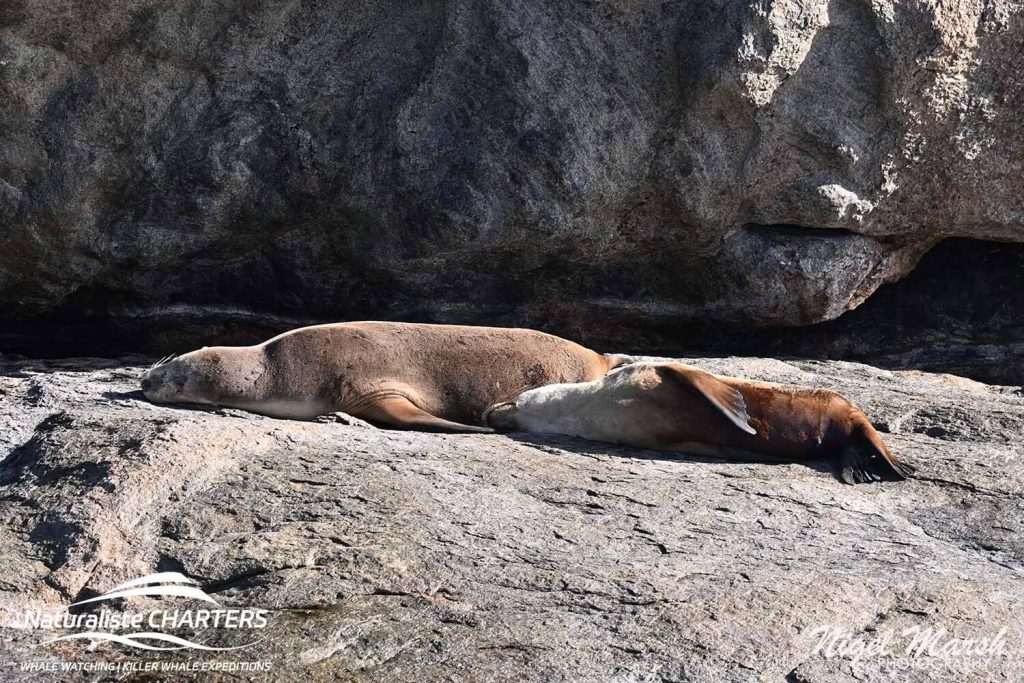
Moments Etched in Ocean Memory
As the week came to a close, we were left with a deep appreciation for the wild, raw beauty of the Southern Ocean. From new life entering the pod to massive bulls carving through the sea, every sighting was a gift.
Each day brought its own rhythm—calm seas, wild swells, close passes, and far-off glimpses. The variety of interactions and species reminded us that out here, no two days are ever the same. These highlights will stay with us long after the sea has settled, and we can’t wait to see what next week brings.
Make that bucket list tick with us on a Bremer Bay Killer Whale Expedition. Based in the beautiful seaside town of Bremer Bay, spend a day at sea on our purpose built 24 metre catamaran.


